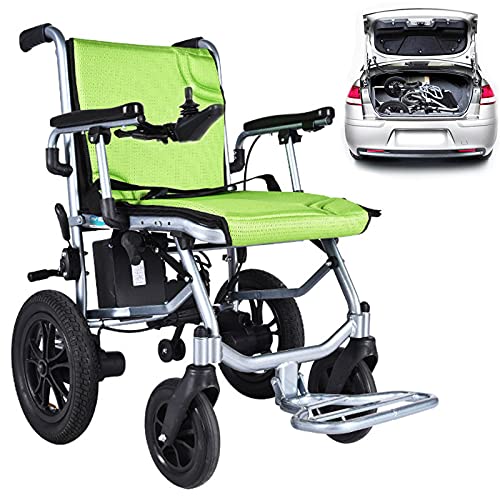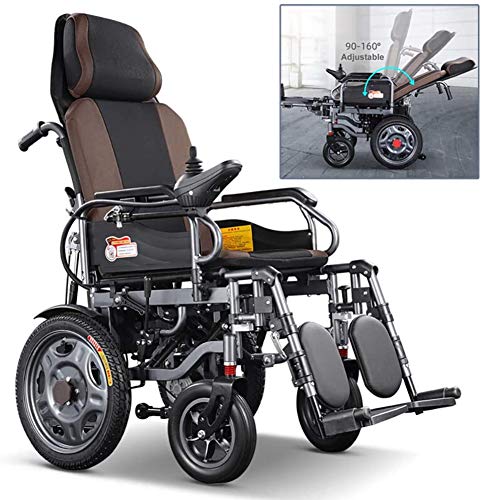Electric Wheelchair With Joystick Isn't As Tough As You Think
페이지 정보
작성자 Bradford 댓글 0건 조회 6회 작성일 24-09-24 01:08본문
 outdoor electric wheelchair indoor wheelchair (from Weelsystem) Wheelchair With Joystick
outdoor electric wheelchair indoor wheelchair (from Weelsystem) Wheelchair With JoystickJoysticks for power wheelchairs can improve their user-friendliness and independence. However, standard joysticks may not accommodate the specific needs of hand dysfunction.
This study assessed the effectiveness and satisfaction of customizing power wheelchair joysticks made using 3D printing technology. The test was conducted using modified power-mobility assessment (PIDA), National Aeronautics and Space Administration Task Load Index and Psychosocial Impact of Assistive Devices Scale.
Control
The control system of a power wheelchair comprises two key components that are the joystick and electronics (also known as the controller). Standard joysticks are mounted on the left or the right side of the wheelchair, whereas more sophisticated rehab chairs come with swing-away mounts that permit the joystick to slide into the middle of the seat.
The manner in which the joystick is placed and used is crucial to its performance for a customer. If a user has a lot of tremors it is important to design the joystick so that the movements don't activate the chair accidentally. Standard EPW joysticks utilize proportional input devices that respond to the deflection of the gimbal to control the chair's movement (similar to an electronic game controller or a car accelerator pedal).
However, there are now numerous alternative control options available for power chair amazon wheelchairs that require only a little force to activate. These include switch controls sip and puff controls as well as head array systems and chin control. While some of these specialty controls require an additional interface to connect them to the wheelchair, most are compatible with the latest generation of joysticks that have incorporated Bluetooth into their handles.
A few standard wheelchair joysticks come with screens to display the state of the system and to give feedback to users. This is particularly beneficial for those who are visually or cognitively impaired. Certain advanced joysticks are able to control various accessories such as televisions, environmental controls and tablet.
 No matter what technology is used the joystick will be as useful as the user is easy to use. It is therefore crucial to consider the dimensions of the buttons and their position on a joystick in order to make them accessible. Also, it is essential to think about the sensitivities of the joystick, which can be adjusted to a variety of levels depending on the requirements of each user.
No matter what technology is used the joystick will be as useful as the user is easy to use. It is therefore crucial to consider the dimensions of the buttons and their position on a joystick in order to make them accessible. Also, it is essential to think about the sensitivities of the joystick, which can be adjusted to a variety of levels depending on the requirements of each user.Comfort
A joystick-controlled wheelchair comes with many advantages that a manual chair does not have. They can reduce fatigue caused by operational factors and are able to travel further than manual-operated chairs. Additionally, they can be used in areas with fewer spaces and more difficult terrain than a manual one, such as uneven surfaces or slopes in the outdoors. With this added independence users will experience an ease of movement that brings new life to their lives and reminds them of how it feels to be independent once more.
There are a variety of powered wheelchairs that are available each with its own unique features. The quantity of bells and whistles a particular model has will depend on the preferences of the user and needs. Some of the most popular features are:
Controls on an electric automatic wheelchair wheelchair that have a joystick can be customized to meet the needs of each individual. This includes the type of knob, ball or handle and how it is mounted. Some joysticks are mounted on the opposite side of the dominant armrest, while others are situated either on the back or front of the seat to allow easy access by a person who is. Certain joysticks can be placed on the side of the seat for those who have limited shoulder range or muscular weakness.
Other features are more personal to you such as the size and shape of the joystick display screen. Some models are backlit or have a color that is more accessible for those with poor vision. Certain models come with additional modes that provide visual or audio navigation cues. They can also offer clocks, odometers and battery charge indicators.
Another important aspect of the joystick is how it can be operated within a tight turning radius. The most efficient models will have a tight turning radius that makes it easier to navigate obstacles in small spaces, like hallways. The narrow radius allows for easier maneuvering in public spaces and in stores. This tight turning circle is especially beneficial for those with mobility issues, such as cerebral palsy, or other mobility issues such as multiple sclerosis, ALS and Huntington's disease, brainstem or spinal cord injury stroke.
Safety
Power wheelchairs are made with safety in mind as a priority. They are equipped with reliable brake systems that can reduce speed swiftly when the user presses the joystick control lever. The chairs also come with anti-tip rear wheels that stop the chair from tipping forward.
The most common type of joystick is a proportional control which is similar to car accelerator pedals and video game controllers in that the more the joystick is moved away from its center, the speed at which the wheelchair moves. These joysticks require finger dexterity and a healthy sense of proprioception. Joysticks that are standard are mounted on the armrest. However there are several special controls that place the control on the middle or side of the seat.
Some people may not have the strength to deflect a joystick's handle even with special rigging. People with spasticity might have issues because their muscles may become stiff or weak. In these cases the use of a head control unit that converts the movement of the user's head into a instruction for the wheelchair could be a better choice.
The size and location of the buttons on the joystick is another factor to be considered. If the buttons are far to the left or difficult to reach, they may hinder the position of the user, and cause a strain on the hands. On the other hand, if the joystick is too far backward, it can be difficult to turn the wheels or maneuver the chair through tight spaces.
Lastly, an electric wheelchair uk wheelchair should always be used with the seatbelt fastened. The most powerful wheelchairs can reach speeds of up to 8 mph and a seatbelt that isn't fastened could result in grave injuries or even death. It is also important to keep batteries charged frequently, and every at night, if you can. This will allow them to have a longer life and help maintain their effectiveness. It's also a good idea to get regular maintenance on your chair to ensure all parts are working properly.
Accessories
The joystick is an essential element of any power wheelchair, and there are numerous accessories that may be added to improve its functionality. These can range from simple switches to more sophisticated interfaces that connect to communication devices and even external environment control units. A more expensive power wheelchair will often have various controller components that can be used and adjusted to meet the needs of a specific client. For example the non-expandable controller would generally only accept the proportional joystick as an input device. However, an expandable controller may allow puff and sip controls, special switches, and head array systems. Some of the more sophisticated controllers can also operate up to 2 power seating actuators, which are able to adjust the position and tilt of the seat.
The most commonly used type of joystick used in clinics is a proportional joystick, also known as a movement-sensing joystick. This type of joystick responds force by increasing output (i.e. The speed of the wheelchair increases when the stick is moved away from the center. This requires a good deal of dexterity as well as a strong proprioception for efficient use.
The technology used today can compensate for small variations in amplitude when EPW driving. However, it is unable to detect and adjust for many more severe unintentional motions, like those that cause by tremors with greater amplitude, or involuntary movements not related to conscious intent like athetosis.
Most wheelchairs have a range of parameters that can be programmed and customized usually with the assistance of a clinician. These parameters include altering the torque generated by the motor and altering the speed of the chair. They can also be used to determine the dead zone which is the distance in which the EPW won't generate an output. Certain controllers will also be able to store backup programs which is useful for a healthcare professional to have on hand in the event of an emergency or for patients with varying symptoms.
댓글목록
등록된 댓글이 없습니다.